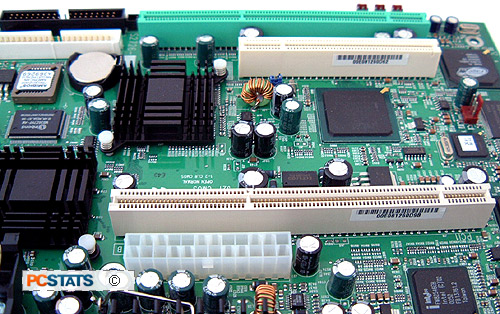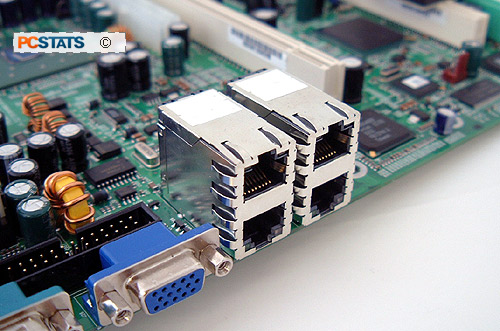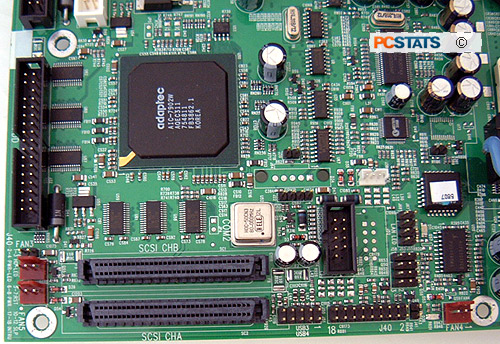Server peripherals require high bandwidth
connections with the chipsets, and other components on the motherboard. The Tyan
Thunder i7501 Xtreme has five independent PCI(-X) buses; undoubtedly designed to
allow each high bandwidth device its own direct connection to the Intel i7501
Northbridge.
If five PCI-X peripherals shared a common bus like
that found on a desktop PC, it would be seriously bandwidth limited.
The white 3.3V 64bit PCI-X slot operates at
133/100/66 MHz, and has a maximum bandwidth of 1Gigabyte/s or
8Gigabit/s when running in 133 MHz mode.
Because the green 3.3V 64-bit PCI-X slot shares one
PCI-X connection with the onboard SCSI controller, it is limited to a maximum of
100 MHz, which means any device in that slot will only receive 800MB/s, or
6.4Gb/s of bandwidth.

The Tyan
Thunder i7501 Xtreme motherboard is available in an
option without onboard SCSI, which in that case would free up the green PCI-X
slot to run at 133 MHz (it would have all the bandwidth to itself). If you plan to install a serverboard such as this into a 19"
rackmount case smaller than 3U, Tyan do sell riser cards
which allow you to expand your system.
The PCI-X hub handles a lot of bandwidth, and to
keep it cool, Tyan have slapped on a simple passive heatsink.
Thrown in for good measure is a regular 5V 33 MHz
32bit-PCI slot, although the potential applications for this are limited unless
a larger 4U rackmont case is used. Sometimes it is good to have a dial-up
connection into a server for specific management requirements, so a PCI slot
would be useful here.
Mega Bandwidth, care of 1, 2, 3...4 Intel
Gigabit NIC's
 You might be asking yourself why does a
serverboard need four Gigabit
network controllers? This question stuck out in my mind when I first saw Tyan Thunder i7501
Xtreme... The answer is pretty clear if you think about it; four Gigabit NIC's bring
a great deal of high-speed network redundancy to the table, and are quite perfect for
high level servers with multiple connections to the outside world. Each pair connects
via the PCI-X 133MHz bus on a Intel 82546 controller.
You might be asking yourself why does a
serverboard need four Gigabit
network controllers? This question stuck out in my mind when I first saw Tyan Thunder i7501
Xtreme... The answer is pretty clear if you think about it; four Gigabit NIC's bring
a great deal of high-speed network redundancy to the table, and are quite perfect for
high level servers with multiple connections to the outside world. Each pair connects
via the PCI-X 133MHz bus on a Intel 82546 controller.
Each of the four GbE network connections can be
connected to an independent backbone or router, and should one connection fail
for whatever reason, the alternate incoming connections will still have GbE link
to the serverboard.
The quad GbE NICs may also have application in
situations where the Tyan serverboard is physically connected to data servers,
isolated networks, or subnetworks.
There is
a lone 10/100 ethernet connection, based on the Intel 825551 controller, but
that's primarily used for maintenance purposes. It allows network administrators
a private connection to work on the server should something go
astray.
Adaptec SCSI included in the
S2726UGN
SCSI (Small
Computers System Interface) is the more dominant
storage method for high-end servers, even if IDE and SATA are slowly
eroding that foothold in the web application arena. The Tyan Thunder i7501
Xtreme includes the Adaptec AIC-7902W Ultra320 SCSI RAID controller built
in.
The Adaptec AIC-7902W shares one PCI-X bus with the
green 3.3V 64bit PCI slot, but that will not prevent the AIC-7902W from
providing enough bandwidth for everyday SCSI320M requirements.

By default the Adaptec AIC-7902W supports RAID
modes 0 and 1. That may not seem very advanced in the face of other RAID
solutions geared towards the server market, but it is perfect for anyone looking
to run a web server with SCSI-based storage.
There are higher forms of RAID, but those
controllers are never integrated onto a motherboard due to their high cost and
speciality. If you need more than what the Adaptec AIC-7902W can provide, I
recommend you disable it in the BIOS, and install a more advanced RAID
controller in one of the motherboard's free PCI-X slots.
If you do not need SCSI, Tyan does also offer a
model of the Thunder i7501 Xtreme without the onboard Adaptec AIC-7902W SCSI
controller.
